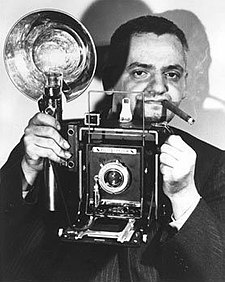 |
| Arthur 'Weegee' Fellig, 1899-1968 |
Weegee was known for his black and white street photography. He started out as a press photographer and conducted his work by following New York City's emergency services. From this, common themes in his street photography surrounded realistic scenes of crimes, injury and death.
As he sold his images to the press, he was selective about what images to shoot. He understood that in some areas of New York brawls occurred quite often and didn't follow up with a compelling story. So he would focus on areas like Park Avenue where such events were more scandalous. These would be the images that he could sell to the tabloid press.


Weegee's photography give us a stark glimpse into human behaviour. I think he documents human behaviour at its worst, through crime and injury. Being a press photographer, I can understand why some of his images cause the spectator to be shocked at what they are looking at. Weegee had to sell his images to make money, so it would appear his themes were apt for selling to the press - real scenes depicting sensationalist stories.
 |
| Lisette Model 1901 - 1983 |
"Photography is the easiest art, which perhaps makes it the hardest."
Model's photography can also be considered 'street photography'. Her focus on unique individual's seems to be a passion of hers. I'm quite fascinated how she manages to tell us so much information about an individual in just one mere photograph.
I quite like how in any of her images, the characters she chooses a larger than life. Take, for instance, the circus man and the singer above - I find it quite humorous that such big personalities are actually physically big people too. This is quite a playful technique Model has used in these images.
***
Both Weegee and Model were huge influences on Diane Arbus. We can see stark similarities in their work. I notice that in all of their images they seem to document a real life moment. Although, I struggle to work out whether Arbus' work is actually staged or not. We could see this a distancing away from the street photography and 'documentary' nature of her predecessors. Nevertheless, there is certainly a lot to 'read' in all of their works and all appear rich in photographic discourse.



No comments:
Post a Comment